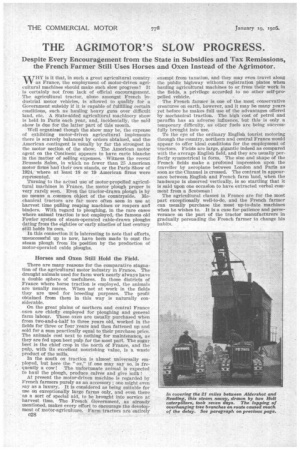THE AGRIMOTOR'S SLOW PROGRESS.
Page 12

If you've noticed an error in this article please click here to report it so we can fix it.
Despite Every Encouragement from the the French Farmer Still Uses Horses State in Subsidies and Tax Remissions, and Oxen Instead of the Agrimotor.
WHY is it that, in such a great agricultural country as France, the employment of motor-driven agricultural machines should make such slow progress? It is certainly not from lack of official encouragement. The agricultural tractor, alone amongst French industrial motor vehicles, is allowed to qualify for a Government subsidy if it is capable of fulfilling certain conditions, such as hauling heavy guns over difficult land, etc. A State-aided agricultural machinery show is held in Paris each year, and, incidentally, the said show is due for the latter part of this month.
Well organized though the show may be, the expense of exhibiting motor-driven agricultural implements there is scarcely balanced by orders obtained, and the American contingent is usually by far the strongest in the motor section of the show. The American motor agent on the Continent appears to have carte blanche in the matter of selling expenses. Witness the recent Brussels Salon, in which no fewer than 25 American motor firms had their own stands, or the Paris Show of 1924, where at least 18 Or 19 American firms were represented.
Turning to the actual use of motor-propelled agricultural machines in France, the motor plough proper is very, rarely seen. Even the tractor-drawn plough is by no means a common object of the countryside. Mechanical tractors are far more often seen in use at harvest time pulling reaping machines or reapers and binders. With regard to ploughing, in the rare cases where animal traction is not employed, the famous old Fowler system of steam-operated cable-drawn ploughs dating from the eighties or early nineties of last century still holds Its 0WD.
In this connection it is interesting to note that efforts, unsuccessful up to now, have been made to oust the steam plough from its position by the production of motor-operated cable ploughs.
Horses and Oxen Still Hold the Field.
There are many reasons for the comparative stagnatiOn of the agricultural motor industry in France. The draught animals used for farm work nearly always have a double sphere of usefulness. In those districts of France where horse traction is employed, the animals are usually mares. When not at work in the fields they are used for breeding purposes, The profit obtained from them in this way is naturally considerable.
On the great plains of northern and central France oxen are chiefly employed for ploughing and general farm labour. These oxen are usually purchased when from two-and-a-half to three years old, worked in the fields for three or four years and then fattened up and sold for a sum practically equal to their purchase price. The animals cost next to nothing for maintenance, as they are fed upon beet pulp for the most part, The sugar beet is the chief crop in the north of France, and the pulp, with its excellent nourishing value, is a waste
product of the mills. .
In the south ox traction is almost universally employed, but here the "ox," if one may say so,' is frequently a cow! The unfortunate animal is expected to haul the plough, produce calves and give milk !
At present the motor-driven machine is regarded by French farmers purely as an accessory ; one might even say as a luxury. It is considered as being suitable for use on exceptionally large farms only, and even there as a sort of special aid, to be brought into service at harvest time. The French Government, as already mentioned, makes every effort to encourage the development of motor-agriculture. Farmtractors are entirely
028 exempt from taxation, and they may even travel along the public highway without registration plates when hauling agricultural machines to or from their work in the fields, a privilege accorded to no other self-propelled vehicle.
The French farmer is. one of the most conservative creatures on earth, however, and it may lie many years yet before he makes full use of the advantages offered by mechanical traction. The high cost of petrol and paraffin has an adverse influence, but this is only a temporary difficulty, as other fuels are being successfully 'brought into use.
To the eye of the ordinary English tourist motoring through the country, northern and central France would appear to offer ideal conditions for the employment of tractors. Fields are large, gigantic indeed as compared with the average English field, and they are usually perfectly symmetrical in form. The size and shape of the French fields make a profound impression upon the traveller by aeroplane between London and Paris as soon as the Channel is crossed. The contrast in appearance between English and French farm land, when the landscape is observed vertically, is RO startling that it is said upon one occasion to have extracted verbal comment from a Scotsman !
The agricultural classes in France are for the most part exceptionally well-to-do, and the French farmer can usually purchase the most 11p-to-date machines when he wishes to. It is a case for patience and perseverance on the part of the tractor manufacturers in gradually persuading the French farmer to change his habits.






























